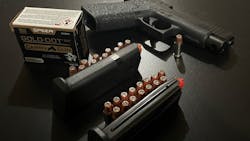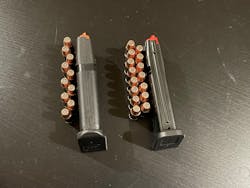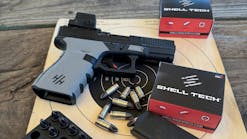Increasing Your Carry Capacity
Well over a hundred years ago, semi-automatic defensive handguns came into being. The Government Model 1911 .45ACP with it’s 7+1 capacity was adopted by the U.S. Army in (go figure) 1911. About 25 years later, the Browning High Power in 9mm with its 12+1 capacity hit the market. The Walther P38 9mm followed about five years later. All three were developed for combat use and were designed within the engineering and metallurgical limits of the time.
Almost from that moment forward, there was an ongoing pursuit of semi-auto handguns that were smaller and lighter. In parallel was the drive to constantly increase round count in the magazine. The challenge, once again, was overcoming design and metallurgical limits. If you wanted more rounds in the magazine, the magazine dimensions had to grow—either in width or length or both. Then in the 1980s we saw polymer frames growing in the market and semi-autos with round counts of 15+ became common. Even then you could see the impact of materials.
The Beretta M9 (92FS in civilian parlance) held 15 rounds of 9mm in its magazine. The Glock Model 17 held 17 rounds in its magazine. The Glock Model 19 was significantly smaller than the Beretta M9 but held an equal number of rounds and had a sight radius (distance between front and rear sight) that was roughly equal. Many people chose the Glock 19 as their carry handgun because it was easier to conceal and more comfortable to wear longer because of its lighter weight. The polymer frame helped a lot.Engineering and materials continued to evolve. Just a few years ago, Glock released the Model 42 in .380ACP and then, a year later, the Model 43 in 9mm. Both guns have a six round magazine capacity making the 6+1 capacity. Shortly after that, the Glock Model 48 was released with a 10+1 capacity in 9mm. For comparison, the Glock 48 was the same height and length as the Glock 19, but noticeably slimmer. What you gave up for that slimmer profile was five rounds of capacity.
Editor’s Side Note: Many experienced shooters observed that 6+1 just isn’t enough for a daily carry defense handgun. Some older shooters observed that, back in the 1960s, 1970s and 1980s, plenty of off-duty guns were five-shot revolvers chambered in .38 Special. So, seven rounds of 9mm was an increase over what used to be and simply required proper planning, awareness and tactics.
The Glock 48 was limited to that 10-round capacity by space and design. The Glock magazines are metal boxes wrapped in polymer. Not only does that make them more resistant to abuse, but it kept contact between parts all polymer. The magazine body’s cut where the magazine catch held it into the gun (or released it when pushed) was polymer. The magazine catch was polymer. If you put a metal box magazine in, the metal—after thousands of rounds fired and hundreds (if not thousands) of magazine reloads—would eat the polymer magazine catch, eventually causing malfunction.Enter Shield Arms company. The engineers at Shield Arms realized that if you changed out the magazine catch to a metal one, and got rid of the polymer that wraps the Glock magazines, you created enough space inside the mag well to put more rounds in the magazine; enough space in fact to put 15 rounds of 9mm in a metal box magazine. By doing so, the Shield Arms’ kit—replacement magazine catch and magazine(s)—the Glock 48 was changed from a 10+1 9mm to a 15+1 9mm. So then you had the equivalent round count of a Glock 19 but in a slimmer profile handgun.
Glock paired the Model 48 frame with the Model 43 slide assembly (which is about 1/2” shorter) to create the Model 43X—a 10+1 9mm that was slightly more concealable. But again, if you put in the Shield Arms Carry Kit, you got a 15+1 9mm carry package.
Not long ago, Shield Arms announced that they will be releasing (this year) a Carry Kit for the Glock Model 43. Using the same technology—a metal magazine catch and metal box magazines—the Shield Arms Glock 43 kit will hold nine rounds of 9mm in a flush fit magazine. That will change the Glock 43 into a 9+1 (10 rounds total) 9mm handgun. It’s literally small enough to put in your pocket.
The Glock 43 is much slimmer than the Glock Model 26—the smallest variant of the double stack Glock 9mm. The Glock 26 has a 10+1 capacity but with the Shield Arms Carry Kit for the Glock 43, you can get 9+1 in an easier to carry and conceal handgun. Shield Arms also announced that they would be releasing extended magazine floor plates - +1 and +2. If you choose to put the +1 on your magazines, while it creates a small extension past the bottom of the mag well on the weapon, it gives you that 10+1 capacity. With the +2 floor plate, you get 11+1 capacity. It would probably be most practical to carry the standard, flush fit nine round magazine in the weapon (9+1 being 10 rounds in the weapon), and then carry a couple backup magazines with the +2 floor plates on them.
No matter how you choose to leverage the technology to suit your particular carry needs, it’s still a game-changer. Taking your Glock 43 from 6+1 to 9+1 (or 11+1) makes it a more attractive option for your daily defense handgun. It also makes it a more significant option for use as a secondary weapon or back up gun.

Lt. Frank Borelli (ret), Editorial Director | Editorial Director
Lt. Frank Borelli is the Editorial Director for the Officer Media Group. Frank brings 20+ years of writing and editing experience in addition to 40 years of law enforcement operations, administration and training experience to the team.
Frank has had numerous books published which are available on Amazon.com, BarnesAndNoble.com, and other major retail outlets.
If you have any comments or questions, you can contact him via email at [email protected].





